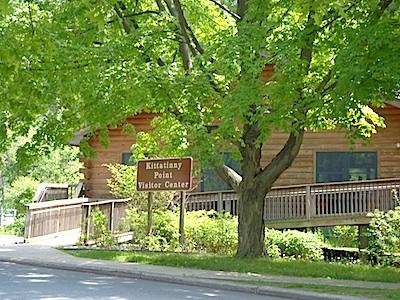
Delaware Water Gap officials will strive this summer to get visitors to understand that the Kittatinny Point Area is primarily an orientation facility and launch point for canoe trips/Kurt Repanshek
With the goal of improving visitor safety, Delaware Water Gap National Recreation Area officials have implemented some new regulations for the Kittatinny Point Area, some of which might not be welcomed by all on a hot summer day.
Not only will rangers crack down on visitors who park illegally on access roads and highway on- and off-ramps in the area located along Interstate 80 on the New Jersey-Pennsylvania border, but swimming at Kittatinny Point will also be banned.
The popular area is located at the base of the two mountains that form the stunning geologic feature known as the Delaware Water Gap, along the banks of the Delaware River, and just off the interstate, making it a very popular destination for visitors. The intended use of Kittatiny Point is to provide visitor information, restroom facilities, a canoe launch, parking, and a short-term picnic facility.
According to NRA officials, the site can accommodate up to 140 vehicles in designated parking spaces. However, on busy days in the past rangers have counted five to six times as many vehicles parked in the area, with most of them illegally parked along access roads and highway on-and off-ramps. Illegally parked vehicles will now be ticketed and towed at the owner's expense.
'The site simply was not designed for, nor can it continue to accommodate, the high numbers of visitors who flock there on weekends,' said Superintendent John Donahue.
When the parking area is full, visitors will be directed to other locations in the park that are designed for swimming and picnicking.
'The safety of our visitors and our employees is always a primary concern for the National Park Service,' added Chief Ranger Eric Lisnik, who is responsible for emergency services at the NRA. One of the new regulations prohibits swimming at Kittatinny Point.
Despite the fact that the site is neither a designated swimming area nor lifeguarded beach, it has become a very popular swimming area for thousands of people who swim there at their own risk each weekend, according to the Park Service. River conditions at that location include swift currents, steep drop-offs, underwater hazards, and river depths of up to 30 feet just a few yards from the shore.
Since 1971, 11 people have drowned while swimming in the Delaware River at Kittatinny Point. More people have lost their lives to drowning at that location than anywhere else in the 40-mile stretch of Delaware River within the recreation area, the Park Service noted. In 2010, the NPS opened Turtle Beach, a lifeguarded beach and picnic area, approximately eight miles north of Kittatinny Point on Old Mine Road in New Jersey. Smithfield Beach, on River Road in Pennsylvania, is only six miles away, and Milford Beach is located at the opposite end of the park just outside the town of Milford, Pennsylvania. All three offer picnic grounds and lifeguarded beaches in the summer. Visitors who come to Kittatinny Point to swim will be directed to nearby lifeguarded beaches.
Grilling or barbecuing, a popular summer activity, is permitted at all three lifeguarded beaches and at all other picnic areas in the park. Visitors must bring their own grills and gas or charcoal; grills are not provided. Grills and ground fires are prohibited at Kittatinny Point. Visitors may use the riverside picnic area for meals that do not involve any cooking, grilling or barbecuing. Alcoholic beverages are prohibited at Kittatinny Point and at all of the lifeguarded beach areas.
Kittatinny Point Visitor Center is open daily through Labor Day from 9 a.m. to 5 p.m.. The visitor center provides park information, maps, souvenirs, and exhibits.

 Support Essential Coverage of Essential Places
Support Essential Coverage of Essential Places







Comments
Here we go again. Nasty ol' NPS trying to regulate everything.